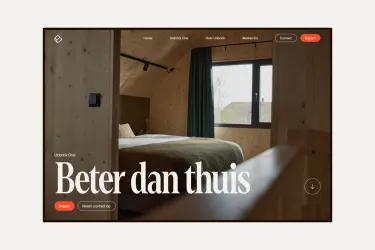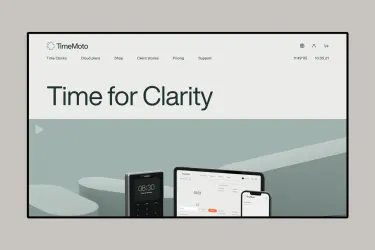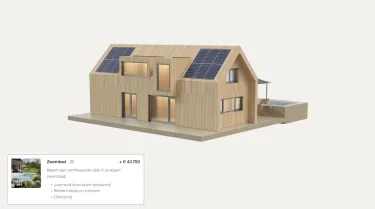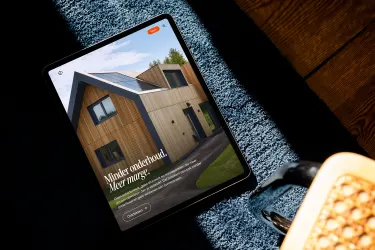Technologie • 16.03.2023
Technologie
Composable architecture provides digital resilience to customer-centric organizations
08 maart 2023
Uncertain times call for resilient organizations. Are you struggling with an IT infrastructure that doesn't allow you to respond quick enough to new customer needs and technology trends? Then it might be time for composable architecture.
This longread on composable architecture (reading time: 8 minutes) addresses the following questions:
Do 'monolithic' software suites limit your flexibility and responsiveness?
Why are more customer journeys turning into digital sameness?
How do you evolve from a multichannel to an omnichannel customer experience?
What is the power of microservices, APIs, cloud-native, and headless (MACH)?
Is a Digital Experience Platform (DXP) the Holy Grail for marketers?
Why doesn't every customer-centric organization immediately switch to Composable Architecture?
Astronomical genius Stephen Hawking once said, "Intelligence is the ability to adapt to change." With a global pandemic, climate crisis, disruptive war, and soaring inflation, we are in a period that seriously tests our adaptability. For many organizations, this adds to the challenge of staying attractive to their customers and employees, and managing their increasingly complex value chains.
The importance of effective software applications and platforms is therefore rapidly increasing. More than one in three companies now consider their software a 'strategically distinguishing factor,' according to recent research by management consultancy McKinsey. "As many as 70 percent of the top economic performers use custom-developed or composite solutions," says Jeremy Schneider, Senior Partner Software & High Tech, "and more and more of the distinctive value of their services and products is determined by that custom-made software."
Delen
‘Monolithic’ applications
The use of 'monolithic' applications is therefore under increasing pressure. Many organizations that experienced significant growth in the past decade owe part of their success to ready-made, versatile software suites. With these, they acquired an all-in-one package for tasks such as maintaining their website or online store, including CRM, CMS, order processing, and any other tools needed, accessible through the same interface with a manageable cost structure. What more could you want?
However, there are also drawbacks to such a convenient 'all-in-one package.' You become increasingly dependent on a single supplier ('vendor lock-in'), which at best releases an upgrade every year, often with limited 'innovative capacity.' Any desired 'extras' in between have to be integrated by yourself, and re-coded with each update. This leads to a lot of hassle and extra complexity. Moreover, the package becomes increasingly intertwined with your entire IT ecosystem, making it increasingly time-consuming to keep it up to date. The risk of system crashes, security risks, and other unpleasant surprises also continues to grow.
Delays, extra work, and increasing costs, just when you need more speed and flexibility
Delays, extra work, and increasing costs, just when you need more speed and flexibility. In addition to the crises mentioned earlier, this need often stems from the razor-sharp battle for your customer's attention. This battle has resulted in two related strategies over the past few years: multichannel and omnichannel. In a multichannel strategy, you continuously add channels and touch points for greater reach. B2B organisations are also fully participating: in 2021, they used twice as many channels and touch points as in 2016 on average, according to research by McKinsey.
Consistent overall experience
Simply being present with all these different touchpoints is no longer enough. "Today's customer expects each of these new stops on their customer journey to truly add value," says renowned customer experience specialist Joseph Michelli, known for books like 'The Starbucks Experience.' "An experience that makes their search or purchase process just a little easier or more beautiful. Due in part to the similar offerings of a number of large all-in-one platforms, many customer journeys are unfortunately turning into a kind of digital sameness."
Read the blog: Why are more and more customer journeys turning into digital sameness?
A truly distinctive experience requires a lot of thought, data analysis, and creativity. Plus, the skills to bring together all these old and new touchpoints into a high-quality overall experience ('brand experience'). After all, the customer who makes a new appointment through customer service wants to see that information immediately in their mobile app. Moreover, more and more customers - consciously or unconsciously - expect you to use all subsequent interactions to better understand them. So that you can better respond to their personal needs and preferences in future interactions.
By evolving from a multichannel to an omnichannel strategy, you can transform a series of 'loose' contact moments into an integrated and personalized customer journey. However, even for organizations with a high degree of digital maturity, this is a serious challenge, let alone if you are also struggling with a patchwork of rapidly aging software at the back end. In recent years, companies such as Adobe, Episerver, IBM, Salesforce, SAP, and Sitecore have increasingly added 'omnichannel' bells and whistles to their 'traditional' CMS suites.
Read the blog: From multichannel to omnichannel: the evolution of the personalised ‘overall experience’
Holy Grail for marketers?
Market researchers like Gartner and Forrester are always at the forefront of providing a resounding context and snappy abbreviations for such 'new developments'. This way, the 'traditional' CMS has evolved in recent years into a Digital Experience Platform, or DXP. Gartner defines the DXP as a "platform that integrates a large number of different technologies to provide a wide spectrum of similar user groups with consistent, secure, and personalized access to information and applications across a large number of digital channels and touchpoints."
So, a kind of Holy Grail for marketers, with which you can orchestrate complex customer journeys from beginning to end. Immediately at the first presentation of its 'Magic Quadrant for Digital Experience Platforms' – a periodic analysis of technology and providers - Gartner itself already noted that this market is still 'in its infancy'. "As a result, there are many different practices and definitions in this market," observed senior director analyst Irina Guseva at the time, "and integrations with internal and external systems are by far the largest cost item."
Read the blog: How to build a custom DXP (Digital Experience platform)?
Composable Architecture
In other words, the suggestion of an all-encompassing DXP platform, with which you can bring everything in-house in one go to create a high-quality omnichannel customer experience from beginning to end, is mainly wishful thinking. In a recent interview, Guseva underlines this conclusion: "Responding quickly to new developments becomes increasingly difficult with monolithic platforms and tech stacks that rely on periodic updates. To meet this need in a truly future-proof way, more and more organizations will therefore switch to a composable architecture."
Composable Architecture is an innovative and rapidly maturing approach to software development. At its core is the principle that all software – no matter how simple – is built using a combination of complementary pieces of functionality. For example, an interface for entering numbers, a calculator that performs calculations with these numbers, a memory that remembers the resulting outcomes, and an output that prints the invoice or sends it by email.
In a standard platform, suite, or package, the developer connects these functions inseparably. Thanks to composable architecture, you can now connect these components as separate elements according to your own insights. This 'modular' approach is not new in the IT world. However, the innovative packaging of these functions into so-called 'microservices' is. As are the application programming interfaces (APIs) that link separate components and 'translate' their communication where necessary. This smart modern approach offers several significant advantages.
Connect like ‘Plug and play’
This way, you can repeatedly combine individual microservices to develop more complex new solutions. The business side, where working with individual microservices can sometimes be a bit (too) abstract, can also make use of numerous existing 'standard packages' of related microservices. These so-called Packaged Business Capabilities (PBCs) are pre-assembled as standard solutions for common business needs. For example, when setting up an online store, you can use existing PBCs for placing an order, optimizing search and filter results, and facilitating the checkout process.
Moreover, with the right APIs, you can also 'plug and play' connect the vast range of cloud-specific ('cloud-native') developed services. Ready-to-use services that each deliver the best possible performance ('best of breed') in your specific situation. But also supportive solutions that make it much easier to apply AI, machine learning, or blockchain technology in your project.
The ability to connect different components via APIs creates another huge advantage. You can now completely decouple the customer-facing front end of your digital infrastructure from the supporting back end. This means, for example, that you can quickly and easily add a new touchpoint to the front end without first tweaking the systems that manage content and customer profiles, process orders, or enable secure payments. This practical application of a composable architecture, where the front and back ends are completely separate, is also called 'headless'.
This popular combination of building blocks in a composable architecture is known by the acronym MACH (Microservices, API-first, Cloud-native & Headless). With composable architecture, it is also possible to configure your digital ecosystem exactly to align with your unique challenges.
A common complaint about 'all-in-one' packages is that they contain numerous features you will never use, partly because your employees simply "can't see the forest for the trees." However, you still pay for all available options.
With a composable ecosystem, you only invest in the 'best of breed' features you genuinely want to use. For example, an e-commerce organization would logically invest more in smart cloud solutions to generate transactions more quickly and easily. Other organizations focus more on personalizing content or better targeting their marketing messages to specific audiences. This is ideal for organizations that want to remain as flexible as possible and prioritize offering an optimal customer experience. And so the question arises: why doesn't every customer-focused organization make the switch immediately?
Conflict of interests between IT and business
The conflict of interests between the IT department and the business side often plays a significant role here. In short, initiatives aimed at a more flexible digital 'front end' logically often come from marketing, sales, and other customer-focused departments. After all, professionals in these areas feel the greatest urgency to respond quickly to new customer needs and (technological) trends. The more internally focused IT organization often concentrates primarily on a solid IT foundation. This foundation should support an organization's core skills ('mission-critical processes') as predictably as possible.
Replacing these extensive systems for Enterprise Resource Planning (ERP) or Customer Relationship Management (CRM) with a composable alternative is also the most complex, and for many organizations, it is not necessary. Of course, the IT department is interested in keeping the entire digital infrastructure as up-to-date and flexible as possible. However, especially in the beginning, replacing an all-in-one package with a series of separate components can add extra complexity and (less transparent) costs, and may require new skills.
It is then up to the business side to substantiate the necessity with solid figures. Although a more flexible digital infrastructure can pay off in numerous ways, calculating concrete return on investment (ROI) is often not easy. Moreover, selecting the right components from the vast array of options requires a lot of new knowledge, as does forging these components into a 'holistic' customer experience. How do I optimally connect touchpoints? And how do I transform the combined (customer) data into valuable insights? A serious challenge, especially as the number of cloud-native services is growing rapidly.
Read blog: True synergy between IT and business thanks to composable architecture
Encourage and facilitate close collaboration between IT and business, and enable them to quickly and flexibly test new opportunities for added value
Clear vision and technology roadmap
"Organizations that truly understand the importance of this challenge address these questions as much as possible at the executive level," Gert van Vliet from composable expert Touchtribe says. "It starts with a clear vision and technology roadmap. What new opportunities will really make a difference for us, and how do we ensure that we make the most of them? You want to work this out in as much detail as possible." According to Van Vliet, the organization's structure should be the priority: "Encourage and facilitate close collaboration between IT and business sides, and enable them to quickly and flexibly test new opportunities for added value. And, of course, you need to have a digital ecosystem that makes this possible."
Software applications and platforms are increasingly becoming a 'strategic differentiating factor' between you and your competition. At the same time, their development speed increases year after year. This also applies to consumer expectations. If you don't want to lose this evolutionary battle, avoid choices that limit or slow down the adaptability of your digital ecosystem. Instead, formulate a flexible strategy that allows as much room as possible for new opportunities and encourage your IT and business side to develop them together.
Composable architecture is ideally suited for this purpose. "You don't have to completely overhaul your entire IT infrastructure," Van Vliet suggests. "Instead, visualize the ideal ecosystem you would set up if you weren't burdened by existing hardware and software or other obstacles. And then work towards that point on the horizon with small steps."
Composable architecture provides the perfect foundation for this. It gives your customer-focused organization additional digital resilience and the freedom to quickly respond to new trends and technological possibilities. As the astronomical genius Stephen Hawking once said, "Intelligence is the ability to adapt to change."
Delen









